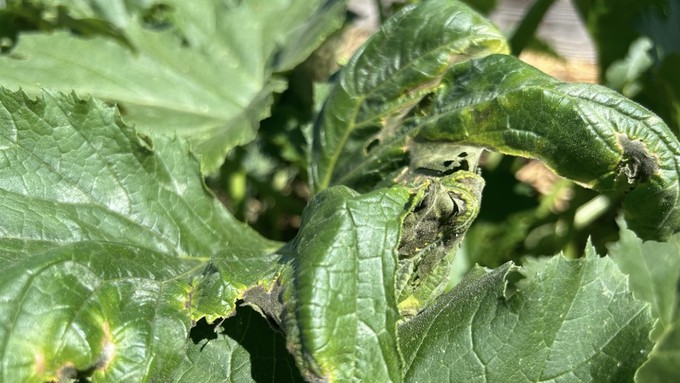
Tips to rescue vegetables, shrubs, container plants and more after too much sun, heat

Even heat-hardy plants such as squash can be damaged by extreme heat and intense sunlight. But don’t clip off the leaves just yet — they still provide shade and photosynthesis. Kathy Morrison
Summer vacations just complicate the problem; no one is around to make up for spotty or inadequate irrigation.
I was reminded of that this week the hard way. Before an extended trip, I had gathered several potted plants together; they usually were hand-watered along the edges of our patio. Instead, I positioned them in two rows so they would all be hit more or less equally by sprayers on a timer. It worked when I tested it. But upon our return, I discovered the plants (all mini roses) closest to the sprayers had grown – and blocked the spray from reaching some plants in the second row.
The first row of roses greeted me with new blooms; two in the second row looked extra crispy with brown leaves.
A similar situation hit my hydrangeas, notoriously thirsty shrubs. Some 6-foot cannas had fallen over and blocked the sprinklers that irrigate the hydrangea’s mixed bed; three bushes looked near death. (So much for those summer blooms.)
Such guilt-inducing summer scenes are common this July; even with fully functioning irrigation, gardens were stressed.
To start this month, Sacramento experienced eight consecutive triple-digit days. After a brief break Tuesday (in the mere high 90s), downtown Sacramento hit a record 113 on Thursday.
According to UC Cooperative Extension master gardeners, “Plants are injured if temperatures become too high in the canopy or root zone, dehydrating tissues and killing plant cells. Damage is more likely the longer plants are exposed to excess heat and if they are moisture stressed, otherwise unhealthy, young, or a species more susceptible to high temperatures.”
To save these heat victims, it’s time for green thumb triage.
First, check the soil moisture around the plant. If you can’t plunge a 6-inch screwdriver into the root zone, that plant is definitely suffering. Give it a long, slow, deep drink, allowing the water to seep in.
The rootball of extremely dehydrated container plants often contract, pulling away from the sides of the pot. The initial response is to fill the pot to the rim with water (and the hose blasting). But instead of moisturizing the roots, the water just shoots down the sides and out the bottom (if the drainage holes aren’t blocked).
To bring back those plants, pull it out of that pot and soak the whole rootball in water for at least a couple of hours or overnight (but not longer). Then, repot with fresh soil or potting mix. Put the plant in a shady spot, protected from afternoon sun, until it shows new growth.
With water, most plants will bounce back quickly. They likely will drop damaged or browned leaves; they’ll need some extra nitrogen to replace that foliage. Give them some well-aged compost mulch; that retains moisture while also slowly feeding the plant.
Without enough water in this triple-digit heat, tomato vines, squash plants and other summer staples may show some dieback. Foliage not only provides energy for the plant, it shades the plant’s fruit. Trimming off the dead leaves and deep-watering plants can prompt new growth, but remember to provide some temporary shade for those baby tomatoes and vegetables.
And don't feed (fertilize) any plant until it has recovered; otherwise, it will just add to the plant's stress.
For more information on heat injury to plants: https://ipm.ucanr.edu/PMG/GARDEN/ENVIRON/thermal.html.
Comments
0 comments have been posted.Sacramento Digs Gardening to your inbox.
Food in My Back Yard Series
May 6: Maintain soil moisture with mulch for garden success
April 29: What's (already) wrong with my tomato plants?
April 22: Should you stock up on fertilizer? (Yes!)
April 15: Grow culinary herbs in containers
April 8: When to plant summer vegetables
April 1: Don't be fooled by these garden myths
March 25: Fertilizer tips: How to 'feed' your vegetables for healthy growth
March 18: Time to give vegetable seedlings some more space
March 11: Ways to win the fight against weeds
March 4: Potatoes from the garden
Feb. 25: Plant a fruit tree now -- for later
Feb. 18: How to squeeze more food into less space
Feb. 11: When to plant? Consider staggering your transplants
Feb. 4: Starting in seed starting
Sites We Like
Garden Checklist for week of May 11
Make the most of the lower temperatures early in the week. We’ll be back in the 80s by Thursday.
* Plant, plant, plant! It’s prime planting season in the Sacramento area. Time to set out those tomato transplants along with peppers and eggplants. Pinch off any flowers on new transplants to make them concentrate on establishing roots instead of setting premature fruit.
* Direct-seed melons, cucumbers, summer squash, corn, radishes, pumpkins and annual herbs such as basil.
* Harvest cabbage, lettuce, peas and green onions.
* In the flower garden, direct-seed sunflowers, cosmos, salvia, zinnias, marigolds, celosia and asters. (You also can transplant seedlings for many of the same flowers.)
* Plant dahlia tubers.
* Transplant petunias, marigolds and perennial flowers such as astilbe, columbine, coneflowers, coreopsis, dahlias, rudbeckia and verbena.
* Keep an eye out for slugs, snails, earwigs and aphids that want to dine on tender new growth.
* Feed summer bloomers with a balanced fertilizer.
* For continued bloom, cut off spent flowers on roses as well as other flowering plants.
* Add mulch to the garden to maintain moisture. Mulch also cuts down on weeds. But don’t let it mound around the stems or trunks of trees or shrubs. Leave about a 6-inch-to-1-foot circle to avoid crown rot or other problems.
* Remember to weed! Pull those nasties before they set seed.
* Water early in the day and keep seedlings evenly moist.